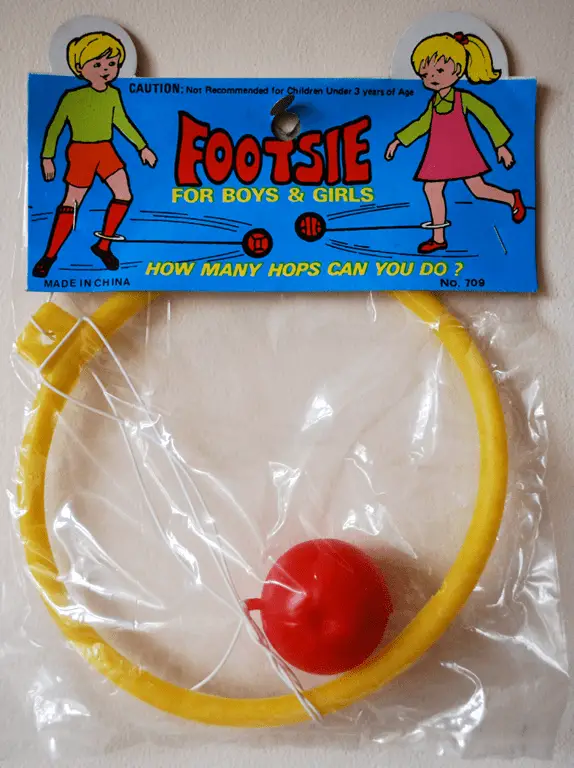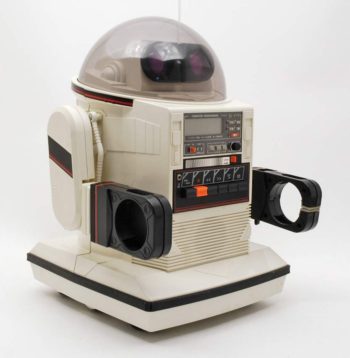
There are many simple toys that have come out over the years, but in the 80s, a
The Skip-it was a children’s toy that was meant to attach at the ankle and spin 360 degrees while jumping over it. It was released by Tiger Electronics and designed by Avi Arad who would use it to move forward and eventually develop the Marvel Cinematic Universe.
The Skip-It was the biggest hit when it came out. I remember the commercials hyping the crap out of this thing and pretty much every girl I knew had one. It wasn’t limited to girls at all as everyone was into it, even though I was awful.
It is such a simple idea but those are the ones that usually are the most successful. The story of the Skip-It goes back to the 60s, was launched in the 80s, and has a bizarre link to the Marvel Cinematic Universe.
What Was The Skip-It?
I’m sure you remember this, but the Skip-It was like a long ball at the end of a rope but this attached around the ankle with a small plastic hoop and could spin around in 360 degrees. The user would then skip
Newer models would have a counter which seems insulting insinuating that we couldn’t skip and count at the same time. Sort of like a can’t walk and chew gum at the same time situation – but we were the generation that grew up eating Play-Do so who knows.
It
You can check out one of the original patents for the Skip-It online and their focus on the physical aspect of the Skip-It in the same way the hula-hoop promoted cardiovascular health. In the patent they state they are looking for the same health benefits that come from a hula hoop:
I’m kind of surprised these never evolved into gyms and health clubs to have Skip-It classes. I might be on to something here…
Another key thing they stress in the patent – and what makes it stand out from the hula-hoop, and the previous iterations I cover next – is the inclusion of a counter.
“In using such a toy, however, it is very easy to lose count of the number of rotations performed as a result of which, the user very quickly loses interest. The fun of playing with such a toy, therefore, could be increased if the number of rotations could be automatically calculated rather than requiring the player or another to maintain a constant visual and repetitive count.”
It All Starts In The 1960s

Kids had been tying crap around their ankles and swinging it around for decades and back in the 1930s, this was a common thing. You just had to take a heavy object, tie a rope around it, and loop it to your foot.
So like most things, the Skip-It is not an original idea and has origins with a similar product called the Lemon Twist, or the “Footsie”. It started in the 60s as companies started to manufacture these homemade toys and they started with two different variants.
The first version of the Footsie toy was a red ball-shaped object that had a bell inside that jingled when moved.
This became popular in the late 60s and early 70s and became more of an activity sport that many people would partake in. It evolved into a group type game with people doing tricks with the Footsie and then also seeing how long they could skip it for. There was also the challenge of doing a single big spin and seeing how long it could keep rotating around for.
The Lemon Twist
Chemtoy then introduced the Lemon Twist, which isn’t a delicious sounding drink but a new version of the Footsie that had a plastic yellow lemon shaped object attached to a plastic loop that was placed around the ankle. The lemon contained rocks in it that rattled when the player would skip and jump over it.
I have just at this moment had a flashback to remembering using, or seeing one of these things that my neighbour had lying around and never had made the connection to the Skip-It until now.
So the Lemon Twist came out – and was trademarked – on December 29, 1975 and it rose to fad status in a very short time. Seriously, the memory of this thing must have been locked away in my mind somewhere and I now distinctly remember it.
Chemtoy is significant as well as it’s the company that brought us Mr. Bubbles and they started out as a chemical supply company in Chicago that sold cleaning supplies. So this the Lemon Twist is clearly the originator but like all toys they tend to fade away from store shelves and memory until another company remembers they were a hit and reintroduces them.
Tiger Electronics Brings Us The Skip-It & Some Other Epic Toys
TIger Electronics started in 1978 and was founded by Randy, Gerald, and Arnold Rissman. They started out making low-tech things like phonographs and then – as you probably know them – got involved in electronic games.
Tiger would eventually start hooking up with companies like Sega to make video games and eventually was taken over by Hasbro.
The people who “created” the Skip-It were Mel Kennedy, Maggie Harvey, and if you are at all familiar with Marvel Comics, Ari Avad.
If It Wasn’t For The Skip-It We Wouldn’t Have The MCU
Before we had the epic Marvel Cinematic Universe, there was a time when the company was pretty much bankrupt and if it wasn’t for Arad the whole thing could have faded away like people dusted after the snap. Let’s take a quick look at how Avi Arad is a pretty monumental person.
Arad was born in 1948 in Israel and is the son of Holocaust survivors for Poland. He was big into Superman and Spider-Man growing up and moved to the U.S. in 1970 to attend Hofstra University. He had no dream of working in toys but that was the first job he could get.
He would end up working for Tiger Electronics and along with Maggie Havery, and Mel Kennedy they would come up with the Skip-It. Thanks to some great commercials – specifically on Nickelodeon and during other kids shows – the Skip-It was a massive commercial success.
This gave Arad more clout as a toy designers and his creations would be sold to many different toy manufactures. Some of the things he came up with include:
- My Pal 2
- Troll Warriers
- Child-sized Harley Davidson
- The Zap It disappearing ink gun
- Baby Wanna Talk
- My Pretty Ballerina
And a ton of other dolls and toys. At the time he was considered “the hottest toy developer in the business”. Arad saw it more than just making and selling toys but he considered himself to be in the entertainment business. This allowed him to sign a deal to work exclusively with “Toy Biz” a New York-based toy company that was founded in 1990. Toy Biz was 46% owned by the Marvel Entertainment Group.
In a New York Times article from 1993, Arad stated that his mission was:
“to ‘‘Exploit’ the Marvel Universe of comic-book characters, which includes the X-Men and Spider-Man, in a synergistic network of toys, video games, films, and television shows.”
In 1993 he was talking about developing an animated X-Men cartoon show for Saturday mornings and other future projects include a Spider-Man series and an X-Men film to be made by 20th Century Fox.
Marvel Almost Goes Bankrupt
Marvel was doing O.K. in 1993 but things started to go downhill. It was first fully bought in 1989 by billionaire Ronald Perelman, he got it for a good price of around $80 million and his thing turning around dying companies for a profit. He made Marvel pump out new titles and a ton of new comics, this worked at first as everyone was snatching them up hoping they would be worth big money down the road.
Profits were up
Everyone to do with Marvel and Toy Biz knew the future was in
Arad and Perlmutter knew they needed to go the movie route but since Marvel was just out of bankruptcy they needed quick cash. They started auctioning off the cinematic rights of their characters to Hollywood. The problem is comic book movies weren’t seen as a sure thing so Marvel would have to sell characters off cheaper than they had expected.
In the late 90s movies like Blade and the original Spider-Man were massive hits but due to the bad deals, Marvel only made fractions of a percent on the money they generated. This was proof that comic book movies could be huge and Arad and Perlmutter were sitting on a goldmine but it seemed inaccessible. In 2003 Marvel was about to sell Captain America to Warner Brothers and Thor to Sony Pictures. Arad and Perlmutter got on the same page deciding to make the movies themselves. They would get all the profit but could crossover many characters between movies the way they did in the comics.
They were set, but they didn’t have any money. By 2005 they finally got a deal with $525 million contributed by Merrill Lynch over 7 years – but there was one BIG condition. Since they didn’t have any cash, they had to put up collateral, and that collateral was the movie rights to ten main characters.
Arad and Perlmutter were in it to win and with the money, they bought back the characters they had sold off that the other studios were happy to dump thinking they didn’t have value such as Black Widow, The Hulk, and Iron Man…..
Their first movie Arad would produce would cast washed up train wreck Robert Downey Jr. as an obscure superhero – and you know how this story ends up.
Wrapping It Up

So bringing us back full circle to the Skip-It, you wouldn’t think a ripped off iconic toy from the 80s would bring us the biggest movie franchise of all time – but it did. If the Skip-It hadn’t become a huge success Avi Arad would not have had the ability to develop other toys and allow his toy making genius to develop. This would never have made him a hot commodity and he never would have
The Skip-It would have a massive resurgence in the 90s and that’s when it really took off. They would introduce electronic versions of it and they’re still kicking around today. There’s even the “Skip-It Twister Rave“ with flashing lights and 20 different levels. You can even get a multi-pack of fitness-based Skip-Its on Amazon that are great for exercise. Its nostalgia and health all rolled into one!
It seems though you can find instructions to make your own homemade ones that may be superior to the commercial versions.
So if you ever see an old Skip-It, or its predecessor the Lemon Twist, give a moment of silence for everything they brought us….
Except for the Howard the Duck movie from 1986, a movie Marvel would rather have you forget. Check my blog all about it right here.




Comments
Comments are closed.